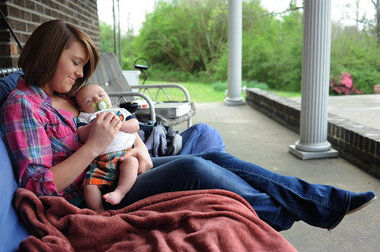˫����������ʵ����µ͵���ͷת��
 �����������»�����ʷ�µ�
�����������»�����ʷ�µ� ����Fertility rates in the United States are continuing their decades-long decline, due in large part to a steep slide in teenage pregnancies down to historic lows, according to a new government report released Thursday.
����The National Center for Health Statistics said the pregnancy rate of 102 pregnancies out of every 1,000 women is 12 percent below the 1990 peak of about 116 per 1,000. Only once in the past 30 years, 1997, has it been lower, and only marginally, the center said.
����Since 1990, the report said, pregnancy rates are down in almost every category. The only exception is among women over 30, whose pregnancy rate has increased steadily with every passing year. But the rate is declining among women in their 20s, who form the single largest group of pregnant women, and among teenagers of all races and ethnicities. The abortion rate also has dropped, reflecting a continuous slide since peaking in 1990.
����The report only examined the trajectory of pregnancy rates through 2009, stopping there because more recent data on abortions is not available yet. But newer statistics on birth rates suggest thedecline is continuing, though not as quickly as it did in recent years when the recession accelerated trends well underway.
����Women already were having fewer children than women of their parents�� and grandparents�� generations, so those under 30 could postpone childbirth until the economy improved without affecting their longstanding goals of having a first or second child.
������What happened was a postponement of births among younger women with a longer time horizon,�� said Andrew Cherlin, a Johns Hopkins University sociologist specializing in family issues. ��Women over 30 couldn��t wait that much longer.��
����While the decelerating decline in birth rates since 2009 reflects the easing of the recession��s impact, the striking drop in teenage pregnancies shows little sign of abating. The teen pregnancy rate in 2009, of about 38 per thousand girls, was 39 percent lower than the 1991 peak of 62. Just four years later, in 2012, it reached a record low of about 29.
����Sally Curtin, one of the report��s authors, said the historic drop is being driven by a long, downward trend of fewer teenagers having sex, and among those who do, a sharp increase in their use of contraceptives.
������It��s as if both sides in the debate over teen pregnancy were right,�� said Cherlin, noting that concerns over the AIDS epidemic may have played a role in the growing use of condoms among teenage boys.
������AIDS has forced many school districts to talk about contraception, even if they didn��t want to,�� he said.
����The national trends are evident in the Washington area.
����Teenage pregnancy rates have plummeted in the District, down to less than a quarter of where they were two decades ago, said Brenda Rhodes Miller, director of the DC Campaign to Prevent Teen Pregnancy. In 1993, the pregnancy rate for teenagers aged 15 to 19 was about 239 per 1,000. By 2011, it was under 55.
������The decline has been amazing,�� she said, adding that the reasons for it are not clear.
����Teen pregnancy rates are declining in every ward, she said, though more slowly in wards 7 and 8, which have the city��s lowest income levels. More than 500 of the 879 births to District teens in 2011 were to residents of those two wards.
����The one-year drop was relatively small. In more affluent wards, the teen pregnancy rate dropped by double digit percentages.
����Even with declining pregnancy rates, the United States still has one of the highest overall birth rates among industrialized countries. The 10 nations with the highest birth rates in the world are all in Africa.
����11��5�շ�����������������ָ���������Ļ����ʼ�ʮ���������ߵͣ��ܴ�̶��������������껳���ʴ���»�����ʷ�µ͵�Ե�ʡ�
�������ҽ���ͳ�����ı�ʾ����1990��ĸ߷�ʱ�ڡ���ÿǧ����Ů��116��������ȣ��������½���12%����ÿǧ��102�����ڹ�ȥ30��䣬ֻ��1997��Ļ����ʱ������Ե͡�
�����������滹ָ������1990���𣬸�������εĻ����ʶ����½����ơ�ֻ��30�����ϵĸ�Ů���⣬���ǵĻ�����ÿ�궼���Ȳ����������ǣ�������������ԣ�20����ĸ�Ů��Ϊ����Ů�Ե����������仳����ȴ�����½�����������1990��ﵽ���ֵ������ߵ͡�
������һ����ֻ�ܽᵽ2009��Ļ����ʱ仯�켣��֮����������ʵ��������ڻ�û��ͳ�ơ�Ȼ���������µij����ʿ��Կ��������������ڽ��ͣ��ٶ�ȴ�ڼ�������������꾭������ʱ���·��������ԡ�
�������ڵĸ�Ů�ձ�����ǵĸ������游�����ĺ����١����ԣ�����30��ķ��ޣ����Եȵ����������ȽϺ�ʱ�������ӣ��Ⲣ��Ӱ������Ҫ1����2�����ӵļƻ���
��������Լ�����ս�˹��ѧ�İ���³���ж�����һλר���о���ͥ������������ѧ�ң�����ʾ�������ڵ����ḾŮ�Ƴ�������ʱ���������30���Ժ�ĸ�Ů�����ѡ������������
����2009���������½��ٶȼ��������������˥�˴�����Ӱ�������ᣬ�������껳�е��������ڴ�����ͣ�˿��û�л���ļ���2009�������껳���ʴ��Ϊÿǧ��38�ˣ���1991��ʱ�����ֵ(ÿǧ����62�˻���)�½�39%������2012�꣬��һ���ʴﵽ��ʷ�µͣ�ÿǧ����29�˻��С�
��������һλ�����д����������͢��ʾ��Խ��Խ�ٵ��������������Ϊ�ѳ�Ϊһ���������ƣ�����Щ��������Ϊ�������꣬Խ��Խ��IJ�ȡ����ҩ�ȱ��д�ʩ�����ƶ��˻����ʵij����µ���
������͢����ʾ���ƺ�֧���뷴�������껳�ж�������ȷ֮��������ָ������Ϊ���ĸ�Ⱦ���̲���Խ��Խ���������ѡ��ʹ�ñ����ס�
������˵�������̲�������ʹ������ѧУ������ڱ��еĽ����γ̣���ʹѧУ������ˡ���
�����ڻ�ʢ�ٵ�������һ���Ʒdz����ԡ�
������ʢ�ٵ�����ֹ�����껳�л�����ܲ��״���ȱ�ʾ������һ�����������껳�����轵����������20��ǰ���ʵ�1/4��1993�꣬15-19��������껳����ԼΪÿǧ����239�˻��У���2011��ʱ����һ�����ѽ���ÿǧ���в���55�˻��С�
��������˵������һ�½�����ʵ����̫���ˡ�������ʾ��������һ�����ԭ�������
������˵�������껳������ÿ���������½����ƣ�����7����8������������ˮƽ��͵ĵ����������ʽ����ٶȽ�����2011�꣬��ʢ�ٵ�����879���������У�500����������������
��������ȵĽ������ǰ���겻����ϸ�ԣ���������껳��������2λ���ı����µ���
�������ܹ��ڻ����ʳ����ߵͣ����������Ƿ�������г�������ߵĹ���֮һ��ȫ�����������ߵ�10�����Ҷ��ڷ��ޡ�
����(���� �Ұ�Ƥ�� �༭ ����)
- Ë«Ó԰ÒÕºÍÊÖ¹¤ÀûÓÚ½µÐÄÔಡ·¢×÷·çÏÕ2013-12-17 14:54
- ÆæÎÅ£º82ËêÀÏÌ«¾¹È»»³ÔÐ40Ä꣨˫Ó2013-12-17 14:31
- ¶¯ÎïË«ÓïȤ֪ʶ£ºÎªºÎ´üÐܵıã±ãÊÇÁ¢·½ÐΣ¿2013-12-17 13:49
- ¶¯ÎïË«ÓïȤ֪ʶ£ºÖí¿ÉÒÔ´òÓÎÏ·£¿2013-12-17 10:14
- Ë«ÓïÐÇ×ù£ºË«×Ó×ù¸»ÎÌ×î¶à ÌìЫ×ù²ÆÔ˵æµ×2013-12-16 18:41
- »éÁä³Æν¸÷²»Í¬ Ö½»éµ½×êʯ»é´óÅ̵ã(Ë«Óï)2013-12-16 18:29
- Ë«Ó°Â˹¿¨Ó°ºóÇí•·¼µÇ´ÇÊÀÏíÄê96Ëê2013-12-16 16:55
- Ë«ÓÆÕÁÖ˹¶Ù´óѧ¾¼Ãϵ½ÌÊڸĽ̺«¾ç¿Î2013-12-16 16:21
- Äã²»µÃ²»ÖªµÄ8¸öÀË·ÑÇ®µÄСϰ¹ß£¨Ë«Ó2013-12-16 14:45
